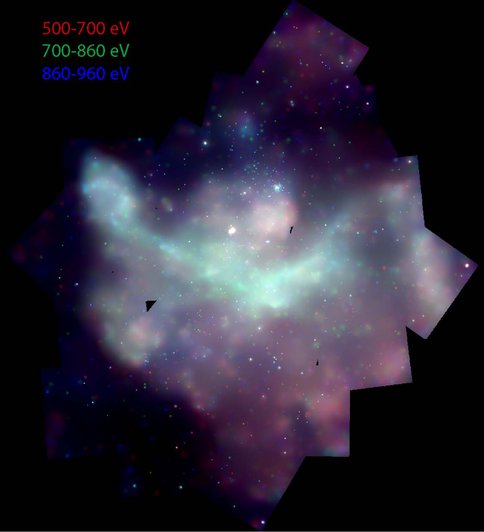2011 Annual Science Report
 NASA Goddard Space Flight Center
Reporting | SEP 2010 – AUG 2011
NASA Goddard Space Flight Center
Reporting | SEP 2010 – AUG 2011
X-Ray Emission From an Erupting Young Star and Diffuse Nebula in the Carina Star Forming Region
Project Summary
High-energy photons in the young stellar environment are known to be important in stimulating chemical reactions of molecules and producing pre-biotic materials. In this reporting period, we approached this problem from two directions: X-ray emission mechanism of a young star that experienced an episodic outburst and spectral characteristics of the diffuse X-ray emission from the Carina massive star-forming region. Notable results are that X-ray variation of V1647 Ori during its mass accretion outbursts in 2003-2005 and from 2008 clearly followed the optical/IR variations that trace the mass accretion activity. However, we also found a possible discrepancy between these bands in the latest data in 2010, and therefore plan to keep monitoring the star in X-rays.
Project Progress
High-energy photons in the young stellar environment are known to be important in stimulating chemical reactions of molecules and producing pre-biotic materials that might later be incorporated into comets. Observational tests are sorely needed to assess the significance of such processing for Astrobiology, and to guide development of theoretical models for chemical evolution in proto-planetary environments. In this reporting period, we approached this problem from two directions: X-ray emission mechanism of a young star that experienced an episodic outburst and spectral characteristics of the diffuse X-ray emission from the Carina massive star-forming region.
We continued studying X-ray characteristics of the erupting young star V1647 Ori through all Chandra observations, concentrating the 2nd optical outburst that started in 2008. Variations in the X-ray luminosity of V1647 Ori are correlated with similar changes in the OIR brightness of this source during two (2003–2005 and 2008-) eruptions, strongly supporting the hypothesis that accretion is the primary generation mechanism for the X-ray outbursts (Teets et al. 2011). We revisited the star with the XMM-Newton and Swift satellites in early 2010. However, the X-ray fluxes significantly decreased during these observations though the optical and infrared fluxes, which trace the mass accretion activity, stayed through 2010 (Figure 1). The result may suggest that a mechanism that drives the high-energy activity decayed before those observations.
Figure 1. X-ray, optical and near-infrared light curves of V1647 Ori.
Cold medium in the interplanetary space, such as comets, emits X-rays probably through exchange of electrons between their cold neutral gas and ionized particles in the solar winds. Fundamentally, such processes could occur at any location where the hot and cold gases meet. We have observed the massive star-forming region, Carina nebula, with the Chandra and Suzaku X-ray observatories. Chandra covered the entire Carina nebula with 1.42 deg2 with 1.2 million second exposures, in total. The X-ray map of the Carina nebula in Figure 2 demonstrates spatial variation in X-ray colors, which represents variations in abundance of iron and oxygen. A detailed spectral analysis shows possible lines from charge exchange process, suggesting that the process works outside the solar system, as well. We also observed a south-west region of the Carina nebula with the Suzaku observatory. Suzaku spectra of this region (Figure 3) clearly show emission lines of neon and oxygen ions and can be fit by a model of two temperature thermal plasma with kT ~0.2 and 0.56 keV. These plasma temperatures are quite similar to those of the central region. The diffuse plasma should be physically connected and may be produced by a similar origin.
Figure 2. X-ray true color image of the Carina nebula, obtained with Chandra
Figure 3. Suzaku spectra of the south-west region of the Carina nebula
Publications
-
Teets, W. K., Weintraub, D. A., Grosso, N., Principe, D., Kastner, J. H., Hamaguchi, K., & Richmond, M. (2011). X-RAY PRODUCTION BY V1647 Ori DURING OPTICAL OUTBURSTS. The Astrophysical Journal, 741(2), 83. doi:10.1088/0004-637x/741/2/83
-
Townsley, L. K., Broos, P. S., Chu, Y-H., Gagné, M., Garmire, G. P., Gruendl, R. A., … Pittard, J. M. (2011). THE CHANDRA CARINA COMPLEX PROJECT: DECIPHERING THE ENIGMA OF CARINA’S DIFFUSE X-RAY EMISSION. The Astrophysical Journal Supplement Series, 194(1), 15. doi:10.1088/0067-0049/194/1/15
-
Townsley, L. K., Broos, P. S., Corcoran, M. F., Feigelson, E. D., Gagné, M., Montmerle, T., … Schulz, N. S. (2011). AN INTRODUCTION TO THE CHANDRA CARINA COMPLEX PROJECT. The Astrophysical Journal Supplement Series, 194(1), 1. doi:10.1088/0067-0049/194/1/1
-
PROJECT INVESTIGATORS:
-
PROJECT MEMBERS:
Kenji Hamaguchi
Co-Investigator
-
RELATED OBJECTIVES:
Objective 2.2
Outer Solar System exploration


